
Visit Shrines
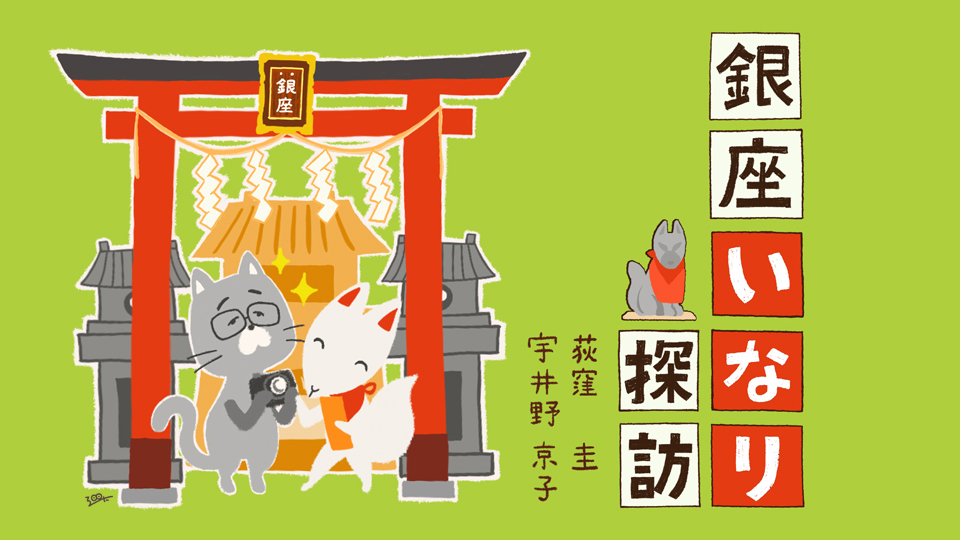
Visit Ginza’s Inari Shrines Vol.12 Mankin Ryujin Seiko Inari Shrine
2022.11.01
“Standing like a Chinese peony.” Sometimes we relate beautiful people to flowers.
Despite its masculine name, Mankin Ryujin Seiko Inari Shrine may teach us how to be as beautiful as a flower.
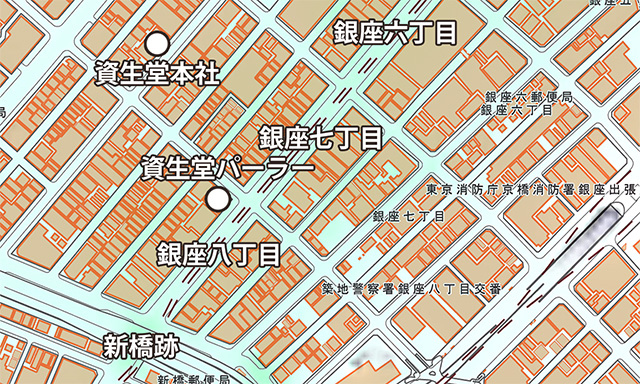
- Ogikubo
- This time we have come to Ginza 7-chome. Where is the shrine?
- Uino
- It is right here. In the Main Office of Shiseido!
- Ogikubo
- So this is the “Tokyo Ginza Shiseido.”
- Uino
- That phrase has a nostalgic ring.
- Ogikubo
- It must have been a TV commercial that I saw all the time when I was a child that said, “Tokyo Ginza Shiseido.” I remember the phrase as one word. And it just suddenly came back to me. I grew up in Nagoya and had no idea what Ginza was like. So, it was a rhythmical phrase that lingered in my mind. Does this mean that Shiseido has an Inari Shrine?
- Uino
- That is right. Today we will visit the Inari Shrine that guards Ginza Shiseido.
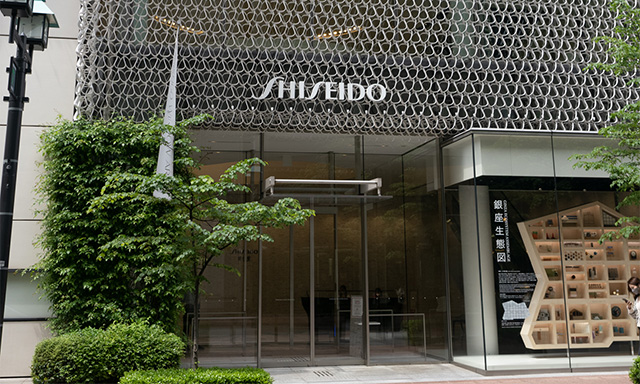
- Ogikubo
- Why is the Japan Photographic Society housed inside Shiseido Main Office?
- Uino
- Shinzo Fukuhara, the first CEO of the company had been educated in the fine arts in France and was also a photographer. After he returned to Japan, he managed Ginza Shiseido’s business, while also founding the “Photographic Art” magazine and taking part in the founding of the “Asahi Camera” magazine. You are well versed with photography, too.
- Ogikubo
- Yes, well versed..I used to have my works published in “Asahi Camera” and some of my photos have been published in full color. I was quite engaged with the magazine. However, I was ignorant not to know that Mr. Shinzo Fukuhara had been involved in its establishment. I truly regret that such a historical magazine as “Asahi Camera” had to be suspended in 2021. It has hurt my income too.
- Uino
- The founder of Shiseido, Arinobu, introduced medical and beauty products, and started a soda fountain that served soda and ice cream and would later become Shiseido Parlor. I suppose Shinzo, the third son of Arinobu, was granted the freedom to study the fine arts because his brothers were to succeed their father. However, due to a sudden change in circumstances, he became the successor to the company.
- Ogikubo
- I guess it is thanks to Shinzo Fukuhara that Shiseido has created such artistic ads that are even remembered by a boy who obviously was not the intended target.
- Uino
- Now let us go into the main story. It is not the first time in this series to learn that a major merchant was so religious that that they took very good care of the household god.
- Ogikubo
- Yes. This Inari deity has a similar background, right?
- Uino
- This deity is generally known as “Seiko Inari,” or the Inari for success, but its formal name is “Mankin Konryu Seiko Inari.”
- Ogikubo
- It is quite an impressive name, isn’t it? It is a combination of “Mankin Ryujin” (dragon god of wealth) and “Seiko Inari” (Inari deity for success). The Seiko Inari was invited here from Toyokawa Inari Shrine by Shinzo Fukuhara in 1954 (Showa 2). Toyokawa Inari is another name for Myogenji Temple in Aichi Prefecture that worships the Dakiniten. The Mankin Ryujin was jointly enshrined from Munakata Taisha, a very old shrine in Fukuoka City that worships the three Munakata goddesses. Ichikishimahime, sitting in Hetsumiya, is a famous water goddess that is also worshiped at Itsukushima Shrine as a festive god. I believe the fact that they worship a goddess perfectly fits the image of Shiseido.
Household gods are often found on the rooftop, I suppose you that it is the same here. - Uino
- Yes. It sits on the rooftop of the Shiseido Main Office building.
- Ogikubo
- Anyone can pay a visit to a deity on the rooftop of a department store, but not everyone can visit one here on the Head Office of Shiseido.
- Uino
- Yes. It is usually a secret deity that does not accept any visitors. Only those working here, including employees can visit.
- Ogikubo
- That is what I had guessed.
- Uino
- However, I acquired special permission this time for the article.
- Ogikubo
- Thank you. Let us go.
- Uino
- Then, let us take the elevator to the rooftop.
- Ogikubo
- There was a board introducing the rooftop just when we got off the elevator. It is called “Shiseido’s Garden” and is made of three areas: “Guardian Forest,” “Tree Shades for Dialogue” “Pond of Knowledge.” It is more like a rooftop garden.
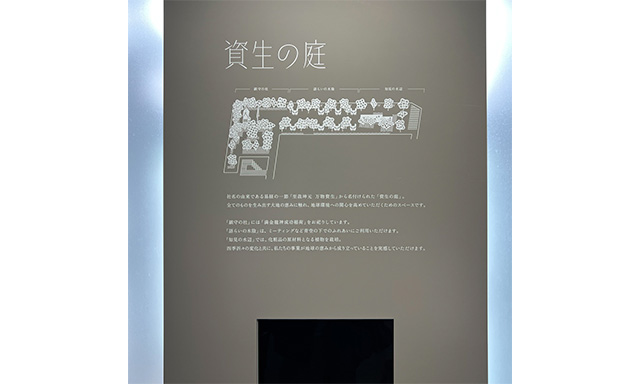
Visitors can gain a clear idea of the concept of the garden.
- Uino
- Yes. Let us have a look at the garden before we visit the shrine. We can go to the “Pond of Knowledge” and through the “Tree Shades for Dialogue.” Then we will arrive at the “Pond of Knowledge.” Then we can visit the shrine.
- Ogikubo
- So the pond in the back is the “Pond of Knowledge.”
- Uino
- The pond is a part of the biotope, where medical plants that are familiar cosmetic ingredients are grown. Cosmetics are made from good quality water and plants ingredients. The garden is like an encyclopedia that presents “Shiseido” itself and its theme: “essence of life.”
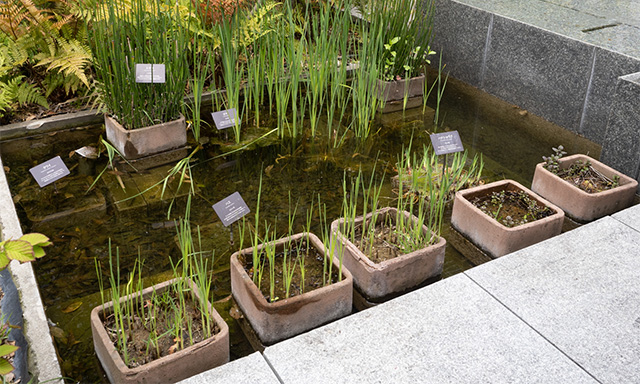
- Uino
- The “Tree Shades for Dialogue” stretch out to the Inari Shrine. Do you see those shrubs planted around the shrine?
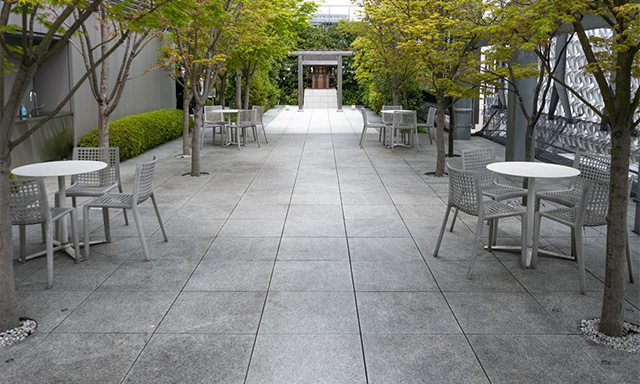
- Ogikubo
- Plants are not my expertise. Oh, but I see. There is just one flower remaining. They are camellias, right?
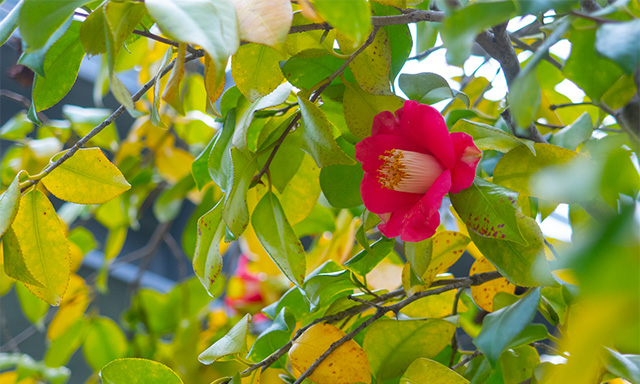
- Uino
- Yes. The “Hanatsubaki (Japanese Camellia)” is the symbol of Shiseido. Various types of camellias are planted here. They are beautiful when they are all in bloom.
- Ogikubo
- I would imagine that to be a fascinating sight. Now, let us visit the shrine.
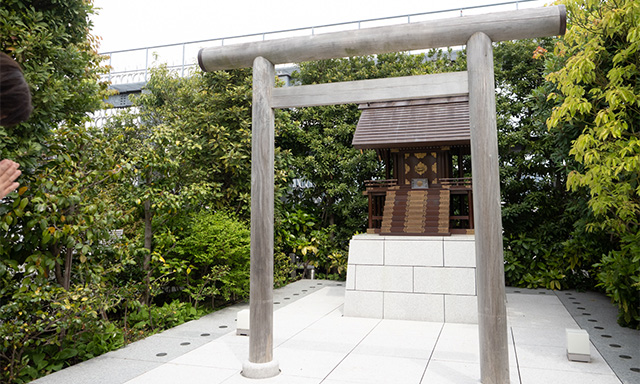
It is usually closed to the public.
- Uino
- It almost looks like the trees are followers of this Inari Shrine.
- Ogikubo
- The name “Mankin Ryujin Seiko Inari” is so powerful that I am sure so many people would want to visit it. It is a pity that it is not open to the public.
- Uino
- That is not to be worried about. When Ginza holds its annual “Haccho Jinja Meguri” event, an Otabisho (temporary shrine) is set up in the lobby of Shiseido Main Office so that all anyone can come it to visit it.
- Ogikubo
- So, anyone can walk into the lobby of Shiseido Main Office during the event. The way camellias are used in the floor and other details of the building is inspiring. I would highly recommend the visit to those interested in the building design, too.
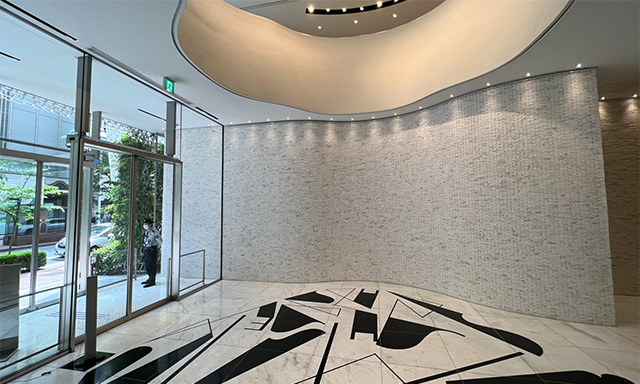
- Ogikubo
- By the way, the view from this building is quite nice. To the sourtheast, we can see the Shiseido Parlor Ginza Main Store. We can easily find it because of its unique color.
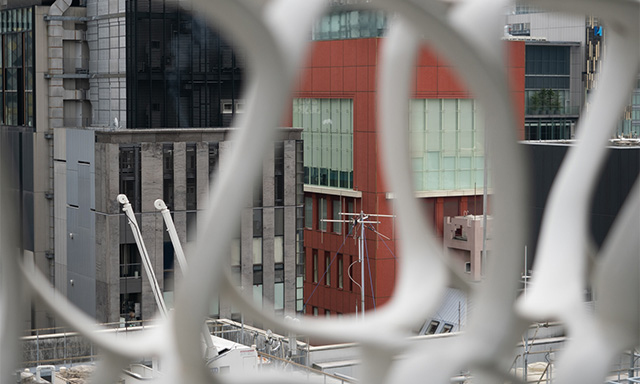
- Uino
- Isn’t it? That building is called the “Tokyo Ginza Shiseido Building.” Have you ever been there?
- Ogikubo
- A long time ago – back in the 1990s – when I used to go around dining at different long-established restaurants, I had lunch there. I was very nervous being in a very high-end restaurant, but I also remember feeling very relaxed and enjoying the excellent food. That is what Shiseido is all about. If you take a look at a map of Kyobashi-ku from 1941 (Showa 16), it says “Shiseido.” So, they have been there all the time.
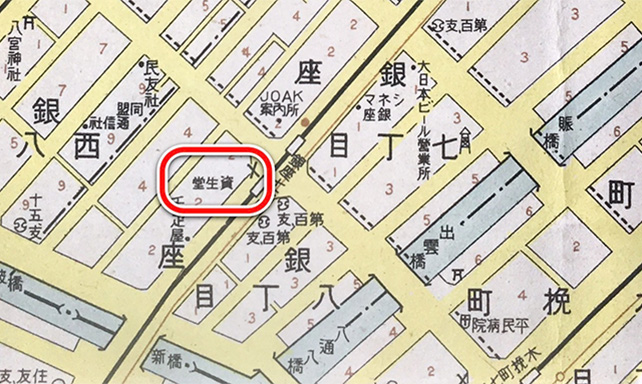
- Uino
- With cosmetics and a parlor, they opened up Ginza’s modern culture. There is so much to know about Ginza.
- Ogikubo
- From Civilization and Enlightenment in the Meiji period to present, Ginza has already been running in the forefront. However, not everything is constantly renewed. Some things remain, gradually creating traditions. These layers of time compose the beauty of Ginza. That is why it is so important to keep records and photos of its history.
All List
- 2020.05.01 Visit Ginza’s Inari Shrines Vol.2 Asahi Inari Shrine
- 2020.08.01 Vol.3 Exploring Ginza in the Edo Period on an old map
- 2020.11.01 Visit Ginza’s Inari Shrines Vol. 4 Kakugo Inari Shrine
- 2021.02.01 Visit Ginza’s Inari Shrines Vol. 5 Azuma Inari
- 2021.05.01 Visit Ginza’s Inari Shrines Vol.6 Kabuki Inari
- 2021.08.01 Visit Ginza’s Inari Shrines Vol.7 Ginza Inari in Ginza 2-chome
- 2021.11.01 Visiting Ginza’s Shrines Vol. 8 Kumagai Inari Shrine
- 2022.02.01 Visit Ginza Shrines Vol. 9 Saiwai Inari Shrine
- 2022.05.01 Visit Ginza’s Shrine Vol. 10 Mimeguri Shrine and Shusse Jizoson on the roof of Mitsukoshi Department Store
- 2022.08.01 Visit Ginza’s Shrines Vol. 11 Komparu Inari
- 2022.11.01 Visit Ginza’s Inari Shrines Vol.12 Mankin Ryujin Seiko Inari Shrine
- 2023.02.01 Visit Ginza’s Shrines Vol.13 Hachikan Shrine
- 2023.05.01 Visit Ginza’s Inari Shrines Vol.14 Hoju Inari Shrine
- 2023.08.01 Visit Ginza’ Inari Shrines Vol. 15 Ryuko Fudo-son
- 2023.11.01 Visit Ginza’s Shrines Vol. 16 Hodo Inari Shrine
- 2024.02.01 Visit Ginza’s Shrines Vol. 17 Toyoiwa Inari Shrine
- 2024.05.01 Visit Ginza’s Inari Shrines Vol. 18 Yasuhira Shrine
- 2024.08.01 Visit Ginza’s Inari Shrines: Final Edition








